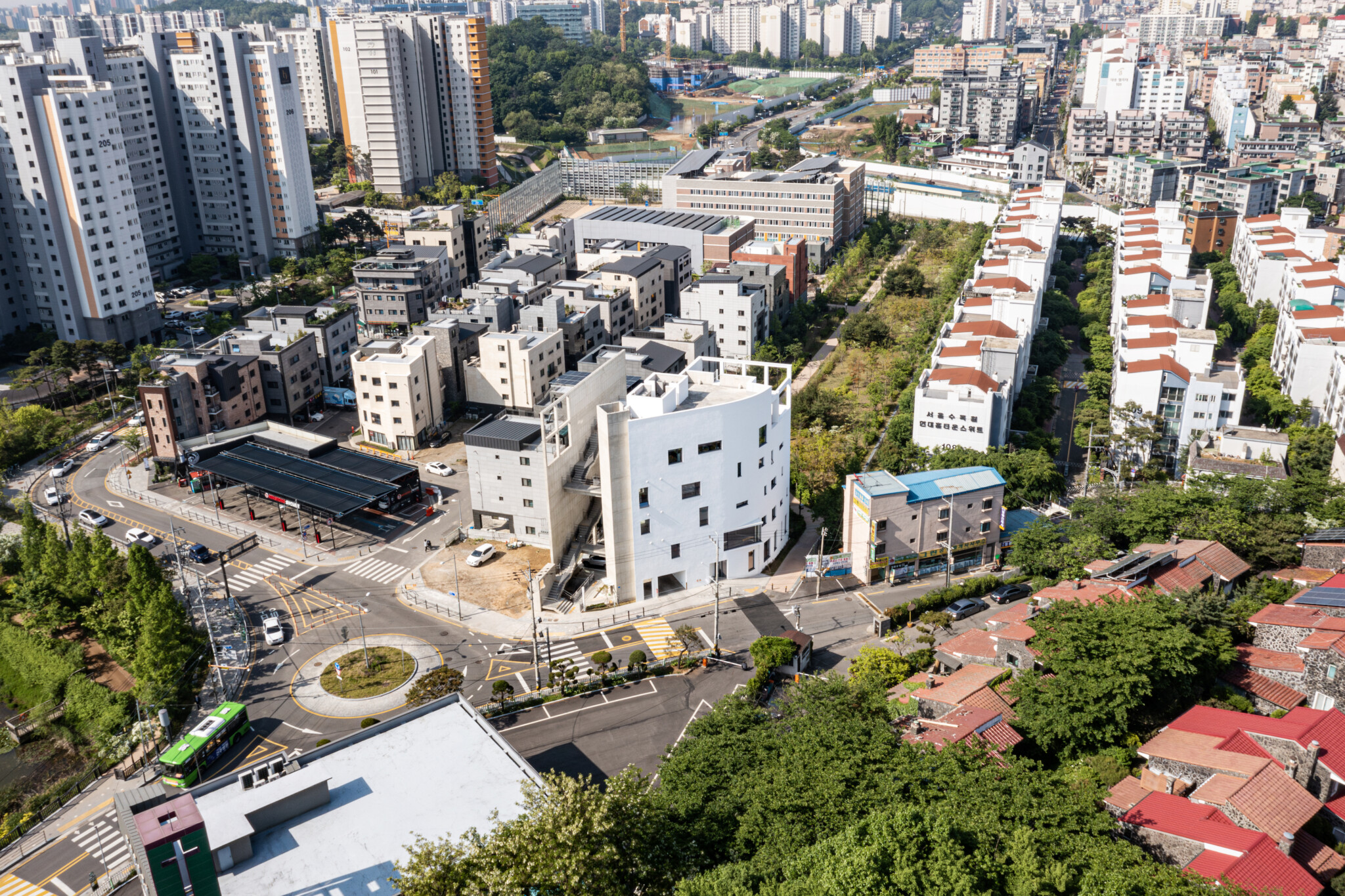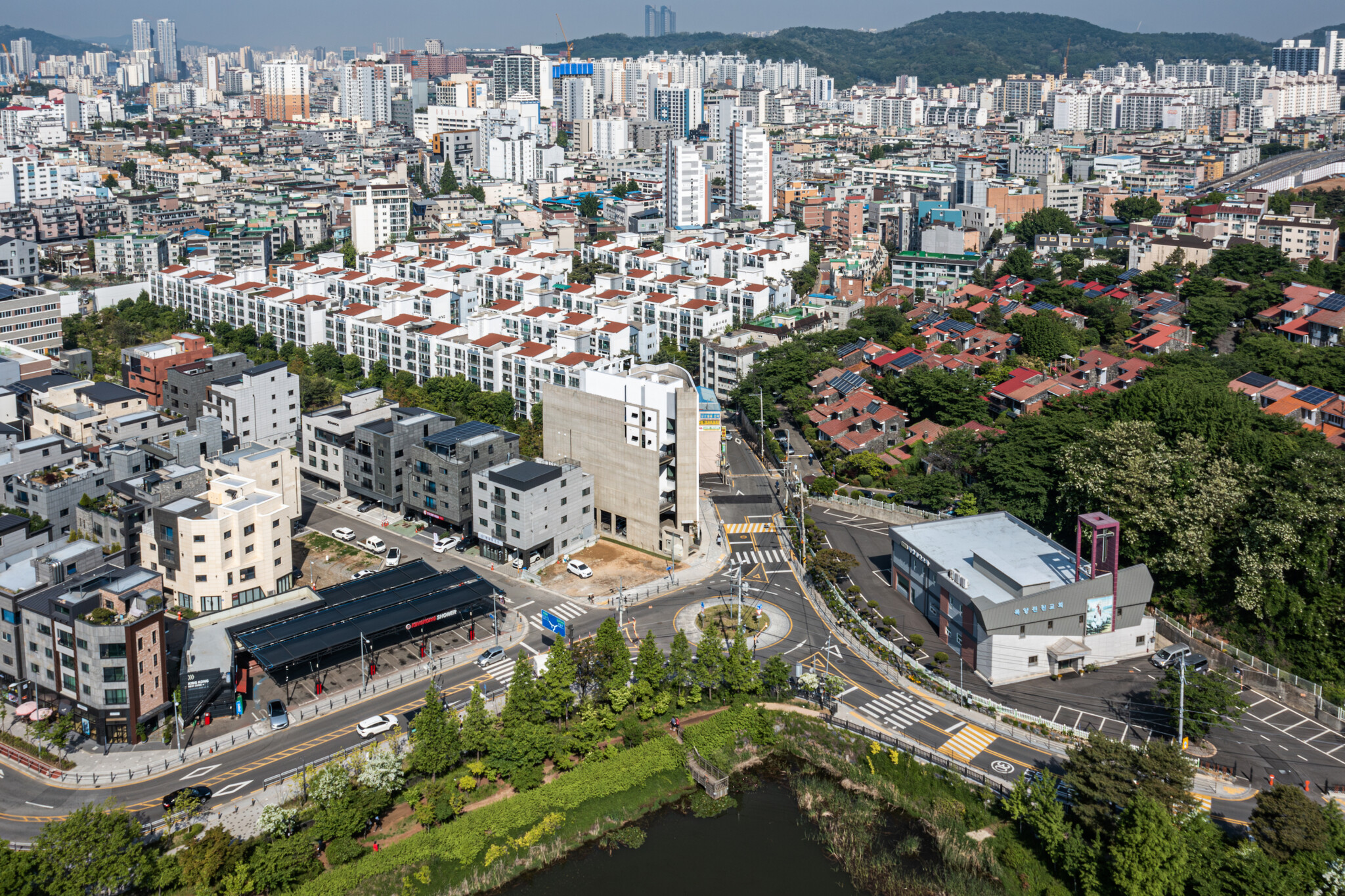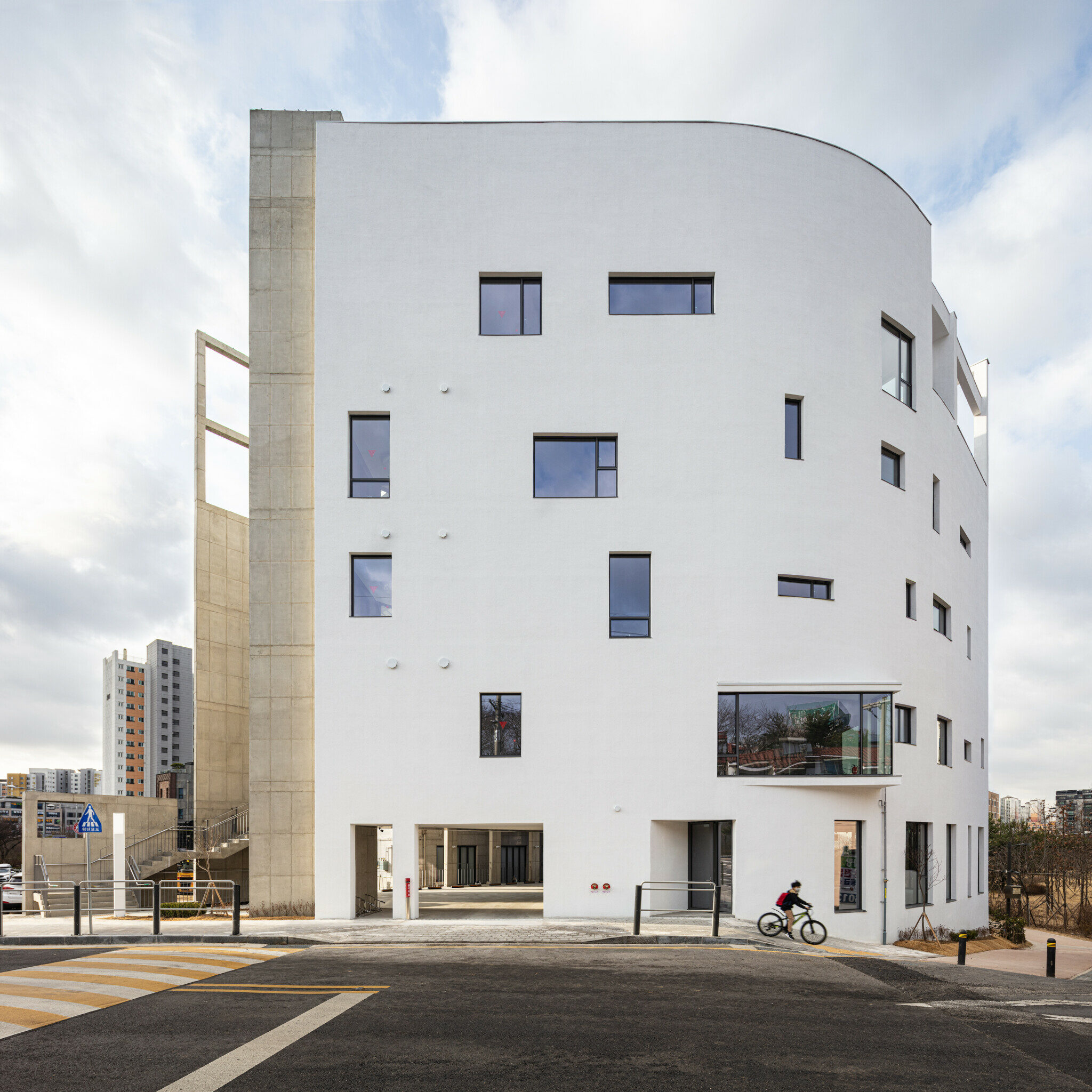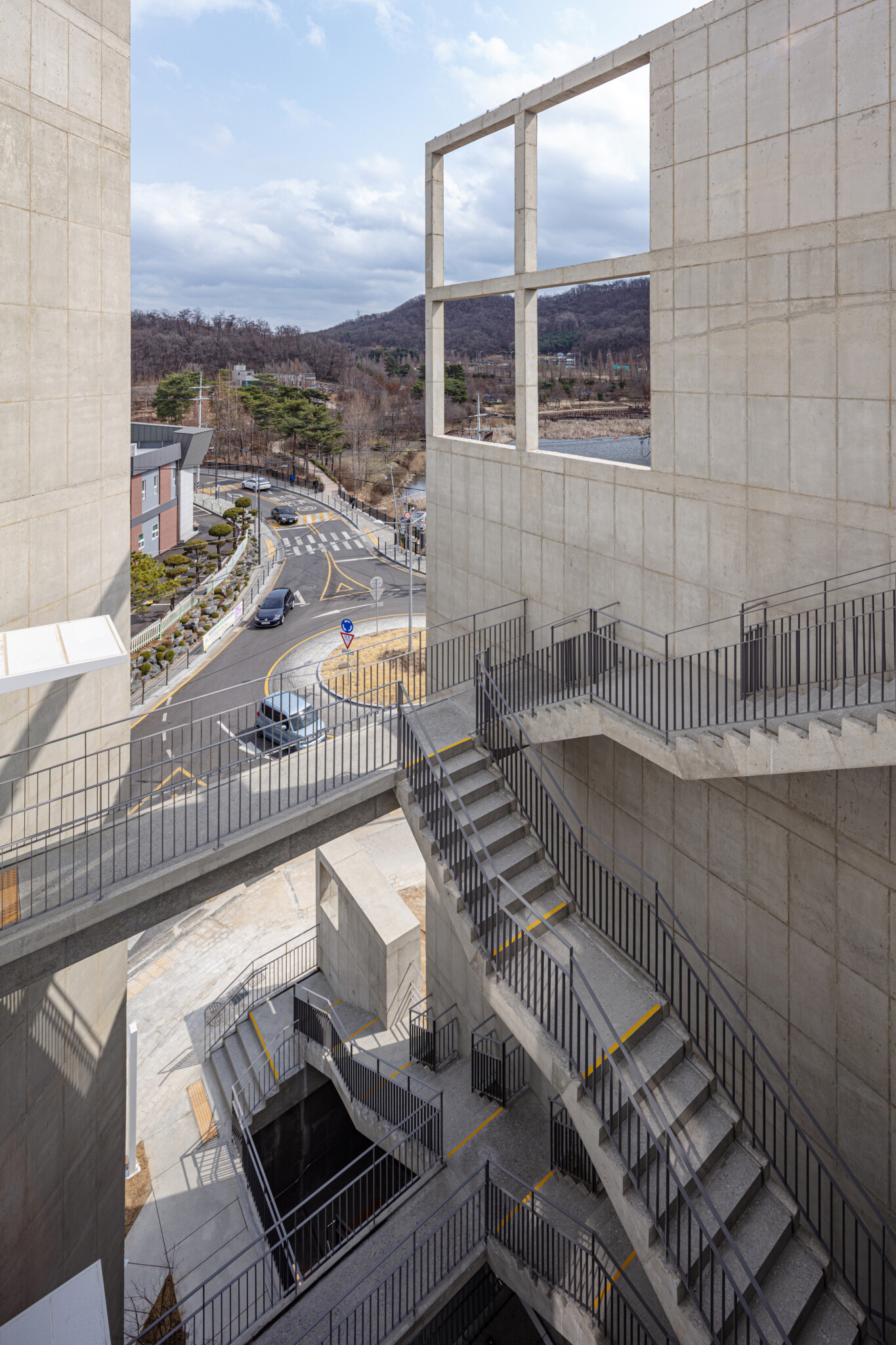Life of the Children
| 완공년도 | 2023 |
| 위치 | 서울 항동 |
| 대지면적 | 591.70m² |
| 건축면적 | 344.67㎡ |
| 연면적 | 1,488.28㎡ |
| Structural engineer | 은구조 |
| Mechanical engineer | 디이테크 |
| Electrical engineer | 대경전기 |
| Contractor | DH |
| Scale | 5F, 1B |
| Lighting design | 뉴라이트 |
| 완공년도 | 2023 |
| 위치 | 서울 항동 |
| 대지면적 | 591.70m² |
| 건축면적 | 344.67㎡ |
| 연면적 | 1,488.28㎡ |
| Structural engineer | 은구조 |
| Mechanical engineer | 디이테크 |
| Electrical engineer | 대경전기 |
| Contractor | DH |
| Scale | 5F, 1B |
| Lighting design | 뉴라이트 |
라이프 오브 더 칠드런.
“전 세계의 소외된 아이들과 함께하기 위해 설립된 아동전문 NGO”라고 스스로를 소개하는 이 ‘라이프 오브 더 칠드런’이 주가 되고, 이와 관련된 일을 하는 몇몇 비영리기구들이 함께 사용하는 건물이다. 그러니 이 건축은 애초부터 월등히 낮은 공사비가 전제된 까닭에 숱한 난관이 예상되어 의뢰 받기를 다소 망설였던 일이었다.
땅은 ‘서울항동공공주택지구’라는 이름으로 개발이 거의 끝난 재개발지역의 북단에 위치하고 있었는데, 기존의 주택지와 이 재개발지구를 가르는 선형의 공원이 시작되는 지점이었고 동편의 길 너머에는 수목원이 있었다. 또한 남쪽으로는 최근에 지어진 3,4층의 상가형주택들이 줄지어 등지고 있었으니, 주변의 정황은 이 건축의 공간구조를 이미 결정하고 있다고 해도 과언이 아니었다. 즉 길 너머의 수목원과 인접한 공원을 연결하는 공간을 설정하여 주 공간으로 삼고 이를 보호하기 위해 남쪽 인접한 상가주택군에는 벽면을 올리고 이 벽면의 건너에 실내공간의 건물을 세우도록 기존의 주변이 요구하고 있었다. 또한 그렇게 하면 그 내부는 탄탄하게 보호될 듯하여 누군가의 사랑과 헌신으로 유지되는 이곳 삶의 풍경에도 어울릴 듯했다. 마침 북쪽 대지선형이 곡선이어서 건물의 외곽선도 이 대지선을 따라 유선형이 되어 건축의 형태는 내부를 감싸안는 모습으로 자연스레 형성된다.
남쪽의 높은 벽면은 잡다하게 보이는 상가주택 모습을 적절히 가리기도 하지만 이 건축물을 오르내리는 계단이 의지하는 장치이다. 이 벽면을 타고 오르면 때로는 공중통로로 때로는 공중마당으로 이어져 건너편의 내부를 들어가게 된다. 이 동선이 진행되는 동안 시선은 서쪽의 공원과 동쪽의 수목원을 연결되면서 공간을 무한히 확장시킨다. 계단을 오르내리고 만나고 헤어지는 모든 움직임이 마당에서 다 관찰되어 마당은 이곳의 일상을 기록하는 공간이다. 게다가 이 공간은 누구에게나 열려 있어 지나는 이를 위한 도시의 쉼터로도 손색이 없다. 더구나 담장이덩쿨로 전체가 덥힐 벽체이고 보면 그 녹색의 풍경은 이 건축을 더욱 살아 있게 할 것이다. 따라서 이 건축은 도시를 매개하고 생명을 매개하는 기지로서 그 사명을 다한다. 바로 소외된 약자에게 우리의 삶이라는 게 아름다울 수 있는 것을 전하기 위해 결성된 이 이타적 단체와 이를 위해 애쓰는 이들에게 맞는 건축일 것이다.
비록 공사비의 한계는 코로나와 우크라이나전쟁으로 더 가중되어 공사기간 내내 심한 압박을 받는 가운데서 최선을 다 하는 시공자의 노력과, 한 푼이라도 더 절약하려 설계를 거듭 바꾸는 필사적인 노력을 경주한 끝에 이 건축은 완공되었다. 완공이 건축의 완성을 의미하지는 않는다. 부족한 부분은 거주자들의 아름다운 삶의 모습으로 풍성하게 채워지며 완성되어 나가길 기대할 뿐이다.
Life of the Children
The building is used by ‘Life of the Children,’ a child-focused NGO established to work with marginalized children worldwide. Several other non-profit organizations involved in related work also share this building. Due to the initially low construction budget, this project faced numerous challenges, which caused some hesitation in taking on the commission.
The site is in the northern part of redevelopment area called ‘Seoul Hangdong Public Housing Zone,’ which was near completion. It is situated at the starting point of a linear park that separates the existing residential area from the redevelopment zone, with a botanical garden located across the road to the east. Furthermore, to the south, there were recently constructed three to four storey commercial-residential buildings lined up. Therefore, it wouldn’t be an exaggeration to say that the surrounding context already determined the spatial structure of this architecture. In other words, the main space was designated by connecting the park adjacent to the botanical garden across the road, and to protect this space, the demand from the neighboring commercial-residential buildings to raise their wall surfaces and construct the interior space behind these walls was evident. Additionally, this approach seemed suitable as it would securely preserve the interior, aligning with the landscape of love and dedication maintained by someone. Coincidentally, the northern boundary line of the site had a curved shape, allowing the building’s outer outline to naturally form around it, enclosing the interior in a seamless manner.
The tall wall on the south side not only effectively conceals the cluttered appearance of the commercial-residential buildings, but also serves as a device for accessing and moving within the architecture. When ascending along this wall, one can occasionally transition from an aerial corridor to an elevated courtyard, eventually entering the interior on the opposite side. Throughout this movement, the gaze connects the western park with the eastern botanical garden, infinitely expanding the sense of space. Every movement of ascending, descending, meeting, and parting on the stairs is observed from the courtyard, which serves as a space for recording the daily life of this place. Moreover, this space is open to everyone and serves as a shelter within the city for passersby. Furthermore, if the entire wall is covered in ivy, the green landscape will further enliven the architecture. Therefore, this building fulfills its mission as a medium between the city and life, conveying the beauty of our lives to the marignalised and embodying the altruistic purpose of the organization formed for this cause.
Although the constraints of the construction budget were further exacerbated by the Covid-19 pandemic and the war in Ukraine, the construction of this building was completed through the relentless efforts of the construction workers who strived their best despite the intense pressure throughout the construction period, and the designers who made desperate efforts to revise the design to save every penny possible. However, completion of the construction does not signify the completion of the architecture itself. The shortcomings will be fille and completed with the beautiful lives of the residents, and we can only look forward to the ongoing enrichment of the building.














